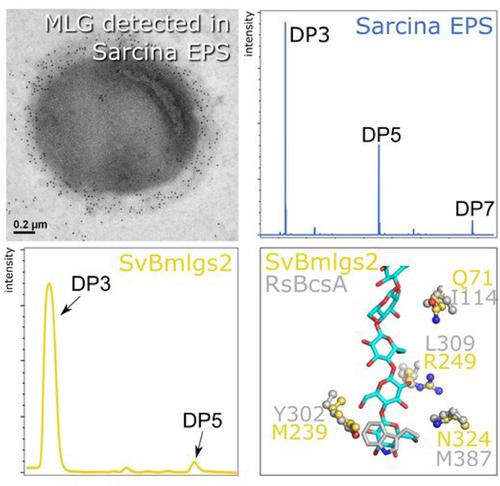当前位置:
X-MOL 学术
›
Mol. Microbiol.
›
论文详情
Our official English website, www.x-mol.net, welcomes your
feedback! (Note: you will need to create a separate account there.)
Glycosyl transferase GT2 genes mediate the biosynthesis of an unusual (1,3;1,4)-β-glucan exopolysaccharide in the bacterium Sarcina ventriculi
Molecular Microbiology ( IF 2.6 ) Pub Date : 2024-05-15 , DOI: 10.1111/mmi.15276 Edwin R Lampugnani 1, 2 , Kris Ford 1, 3 , Yin Ying Ho 1 , Allison van de Meene 1, 4 , Jelle Lahnstein 5 , Hwei-Ting Tan 5 , Rachel A Burton 5 , Geoffrey B Fincher 5 , Thomas Shafee 3 , Antony Bacic 1, 3 , Jochen Zimmer 6, 7 , Xiaohui Xing 8 , Vincent Bulone 5, 8 , Monika S Doblin 1, 3 , Eric M Roberts 9
Molecular Microbiology ( IF 2.6 ) Pub Date : 2024-05-15 , DOI: 10.1111/mmi.15276 Edwin R Lampugnani 1, 2 , Kris Ford 1, 3 , Yin Ying Ho 1 , Allison van de Meene 1, 4 , Jelle Lahnstein 5 , Hwei-Ting Tan 5 , Rachel A Burton 5 , Geoffrey B Fincher 5 , Thomas Shafee 3 , Antony Bacic 1, 3 , Jochen Zimmer 6, 7 , Xiaohui Xing 8 , Vincent Bulone 5, 8 , Monika S Doblin 1, 3 , Eric M Roberts 9
Affiliation

|
Linear, unbranched (1,3;1,4)-β-glucans (mixed-linkage glucans or MLGs) are commonly found in the cell walls of grasses, but have also been detected in basal land plants, algae, fungi and bacteria. Here we show that two family GT2 glycosyltransferases from the Gram-positive bacterium Sarcina ventriculi are capable of synthesizing MLGs. Immunotransmission electron microscopy demonstrates that MLG is secreted as an exopolysaccharide, where it may play a role in organizing individual cells into packets that are characteristic of Sarcina species. Heterologous expression of these two genes shows that they are capable of producing MLGs in planta, including an MLG that is chemically identical to the MLG secreted from S. ventriculi cells but which has regularly spaced (1,3)-β-linkages in a structure not reported previously for MLGs. The tandemly arranged, paralogous pair of genes are designated SvBmlgs1 and SvBmlgs2. The data indicate that MLG synthases have evolved different enzymic mechanisms for the incorporation of (1,3)-β- and (1,4)-β-glucosyl residues into a single polysaccharide chain. Amino acid variants associated with the evolutionary switch from (1,4)-β-glucan (cellulose) to MLG synthesis have been identified in the active site regions of the enzymes. The presence of MLG synthesis in bacteria could prove valuable for large-scale production of MLG for medical, food and beverage applications.
中文翻译:

糖基转移酶 GT2 基因介导细菌八叠球菌中不寻常的 (1,3;1,4)-β-葡聚糖胞外多糖的生物合成
线性、无支链 (1,3;1,4)-β-葡聚糖(混合连接葡聚糖或 MLG)常见于草类细胞壁中,但也在基底陆地植物、藻类、真菌和细菌中检测到。在这里,我们证明来自革兰氏阳性细菌室八叠球菌的两个 GT2 糖基转移酶家族能够合成 MLG。免疫透射电子显微镜表明,MLG 作为胞外多糖分泌,可能在将单个细胞组织成八叠球菌属物种特征的包中发挥作用。这两个基因的异源表达表明它们能够在植物中产生 MLG,包括化学上与S. ventriculi细胞分泌的 MLG 相同的 MLG,但其结构中具有规则间隔的 (1,3)-β-连接之前没有针对 MLG 进行过报道。串联排列的旁系同源基因对被命名为SvBmlgs1和SvBmlgs2 。数据表明,MLG 合酶已进化出不同的酶机制,用于将 (1,3)-β- 和 (1,4)-β- 葡萄糖基残基掺入单个多糖链中。与从 (1,4)-β-葡聚糖(纤维素)到 MLG 合成的进化转变相关的氨基酸变体已在酶的活性位点区域中被发现。细菌中 MLG 合成的存在对于大规模生产用于医疗、食品和饮料应用的 MLG 具有重要价值。
更新日期:2024-05-15
中文翻译:

糖基转移酶 GT2 基因介导细菌八叠球菌中不寻常的 (1,3;1,4)-β-葡聚糖胞外多糖的生物合成
线性、无支链 (1,3;1,4)-β-葡聚糖(混合连接葡聚糖或 MLG)常见于草类细胞壁中,但也在基底陆地植物、藻类、真菌和细菌中检测到。在这里,我们证明来自革兰氏阳性细菌室八叠球菌的两个 GT2 糖基转移酶家族能够合成 MLG。免疫透射电子显微镜表明,MLG 作为胞外多糖分泌,可能在将单个细胞组织成八叠球菌属物种特征的包中发挥作用。这两个基因的异源表达表明它们能够在植物中产生 MLG,包括化学上与S. ventriculi细胞分泌的 MLG 相同的 MLG,但其结构中具有规则间隔的 (1,3)-β-连接之前没有针对 MLG 进行过报道。串联排列的旁系同源基因对被命名为SvBmlgs1和SvBmlgs2 。数据表明,MLG 合酶已进化出不同的酶机制,用于将 (1,3)-β- 和 (1,4)-β- 葡萄糖基残基掺入单个多糖链中。与从 (1,4)-β-葡聚糖(纤维素)到 MLG 合成的进化转变相关的氨基酸变体已在酶的活性位点区域中被发现。细菌中 MLG 合成的存在对于大规模生产用于医疗、食品和饮料应用的 MLG 具有重要价值。






























 京公网安备 11010802027423号
京公网安备 11010802027423号